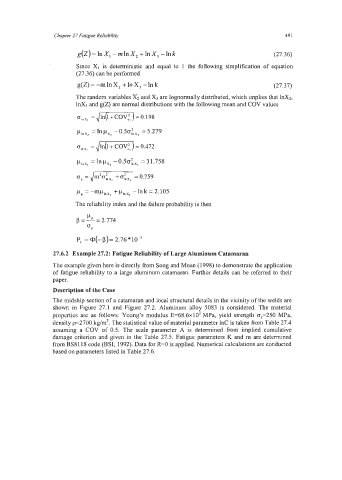Page 515 - Marine Structural Design
P. 515
Chapter 27 Fatigue Reliability 491
g(Z)=InX, -mlnX2 +InX3 -Ink (27.36)
Since XI is deterministic and equal to 1 the following simplification of equation
(27.36) can be performed
g(Z)=-mInX, +InX, -Ink (27.37)
The random variables X2 and X3 are lognormally distributed, which implies that 111x2,
la3 and g(Z) are normal distributions with the following mean and COV values
~
~
~
G , =,/mj=0.198
p,nxz =lnpxz -0.50;~~ =5.279
,/-)
chX, = 0.472
=
p,”,, = In px3 - 0.50:~~ = 3 1.758
+
ng = ,/mzcr~xz nix, = 0.759
p8 =-mphxz +phX, -Ink=2.105
The reliability index and the failure probability is then
P
p = 2 2.774
=
=g
P, = @(-p)= 2.76*10”
27.6.2 Example 27.2: Fatigue Reliability of Large Aluminum Catamaran
The example given here is directly from Song and Moan (1998) to demonstrate the application
of fatigue reliability to a large aluminum catamaran. Further details can be referred to their
paper.
Description of the Case
The midship section of a catamaran and local structural details in the vicinity of the welds are
shown in Figure 27.1 and Figure 27.2. Aluminum alloy 5083 is considered, The material
properties are as follows: Young’s modulus E=68.6x103 MPa, yield strength 0,=250 MPa,
density p=2700 kg/m3. The statistical value of material parameter 1nC is taken from Table 27.4
assuming a COV of 0.5. The scale parameter A is determined from implied cumulative
damage criterion and given in the Table 27.5. Fatigue parameters K and m are determined
from BS8118 code (BSI, 1992). Data for R=O is applied. Numerical calculations are conducted
based on parameters listed in Table 27.6.

